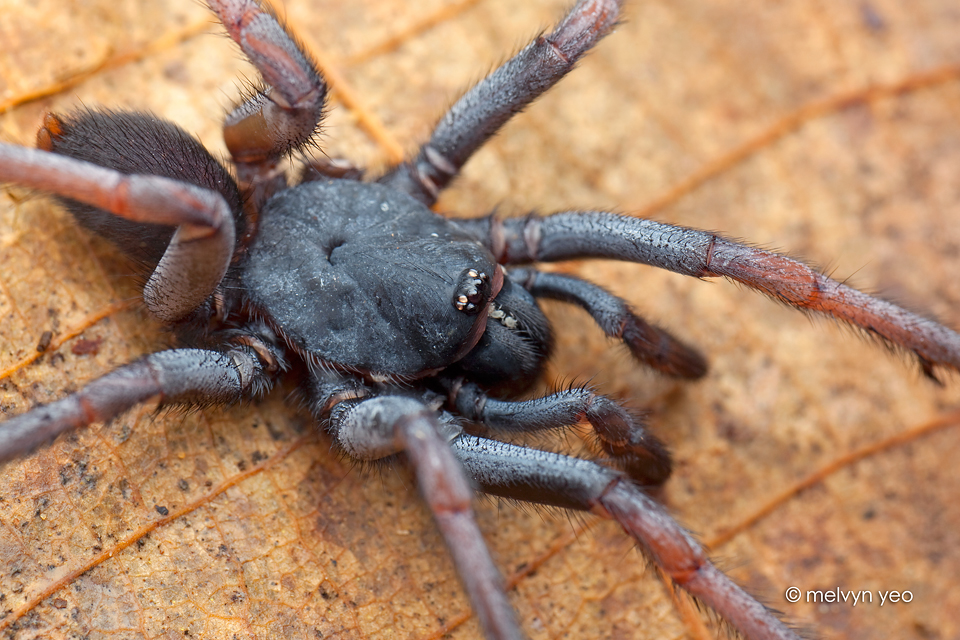ShopDreamUp AI ArtDreamUp
Deviation Actions
Description
First time see a Tube Trapdoor Spider in Singapore. Could be outside looking for a mate 
Quote [link]
Trapdoor spiders (superfamily Ctenizoidea, family Ctenizidae) are medium-sized mygalomorph spiders that construct burrows with a cork-like trapdoor made of soil, vegetation and silk. Some similar species are also called trapdoor spiders, such as the Liphistiidae, Barychelidae, Cyrtaucheniidae and some Idiopidae and Nemesiidae. Some Conothele species do not build a burrow, but construct a silken tube with trapdoor in bark crevices.
The trapdoor is difficult to see when it is closed because the plant and soil materials effectively camouflage it. The trapdoor is hinged on one side with silk. The spiders, which are usually nocturnal, typically wait for prey while holding on to the underside of the door with the claws on their tarsi. Prey is captured when insects, other arthropods, or small vertebrates disturb the 'trip' lines the spider lays out around its trapdoor, alerting the spider to a meal within reach. The spider detects the prey by vibrations and, when it comes close enough, leaps out of its burrow to make the capture.
male Latouchia parameleomene from Okinawa
A hungry individual will wait halfway outside of its burrow for a meal. Male trapdoor spiders can overcome the female's aggressive reactions to their approach, but it is not known how. Females never travel far from their burrows, especially if they have an egg sac. During this time, the female will capture food and regurgitate it to feed her spiderlings. Enemies of the trapdoor spider include certain pompilids (spider wasps), which seek out the burrows and manage to gain entrance. They sting the owner and lay their eggs (usually one per spider) on its body. When the egg hatches, the larva devours the spider alive.
Unlike other mygalomorph spiders, the Ctenizidae have a rastellum on the chelicera. Resembling "teeth" or "barbs" on each fang, this modification is used to dig and gather soil while constructing a burrow. They use their pedipalps and first legs to hold the trapdoor closed when disturbed.
There are about 120 described species of trapdoor spiders.
Quote [link]
Trapdoor spiders (superfamily Ctenizoidea, family Ctenizidae) are medium-sized mygalomorph spiders that construct burrows with a cork-like trapdoor made of soil, vegetation and silk. Some similar species are also called trapdoor spiders, such as the Liphistiidae, Barychelidae, Cyrtaucheniidae and some Idiopidae and Nemesiidae. Some Conothele species do not build a burrow, but construct a silken tube with trapdoor in bark crevices.
The trapdoor is difficult to see when it is closed because the plant and soil materials effectively camouflage it. The trapdoor is hinged on one side with silk. The spiders, which are usually nocturnal, typically wait for prey while holding on to the underside of the door with the claws on their tarsi. Prey is captured when insects, other arthropods, or small vertebrates disturb the 'trip' lines the spider lays out around its trapdoor, alerting the spider to a meal within reach. The spider detects the prey by vibrations and, when it comes close enough, leaps out of its burrow to make the capture.
male Latouchia parameleomene from Okinawa
A hungry individual will wait halfway outside of its burrow for a meal. Male trapdoor spiders can overcome the female's aggressive reactions to their approach, but it is not known how. Females never travel far from their burrows, especially if they have an egg sac. During this time, the female will capture food and regurgitate it to feed her spiderlings. Enemies of the trapdoor spider include certain pompilids (spider wasps), which seek out the burrows and manage to gain entrance. They sting the owner and lay their eggs (usually one per spider) on its body. When the egg hatches, the larva devours the spider alive.
Unlike other mygalomorph spiders, the Ctenizidae have a rastellum on the chelicera. Resembling "teeth" or "barbs" on each fang, this modification is used to dig and gather soil while constructing a burrow. They use their pedipalps and first legs to hold the trapdoor closed when disturbed.
There are about 120 described species of trapdoor spiders.
Image size
960x640px 512.27 KB
© 2013 - 2024 melvynyeo
Comments5
Join the community to add your comment. Already a deviant? Log In
Cool shot!































